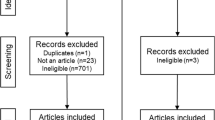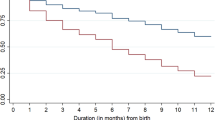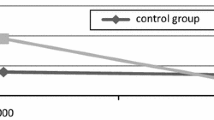Abstract
A two-child policy has been in effect in rural areas in multiple Indian states for over 2 decades. We examine the effectiveness of the policy on fertility, sex ratio, and female infant mortality. We utilize data from the fourth round of the National Family Health Survey (2015–2016) and use propensity score matching models to examine whether the policy influences household fertility behavior. First, fertility behavior of women residing in policy states who married before the mandate are compared to those who married after the mandate. Second, fertility behavior of women residing in policy states are compared to those living in non-policy states. The policy is found to lower the number of children in a household and to decrease the likelihood of having more than two children. However, pre-policy absence of a male child is positively and statistically significantly associated with excess fertility, higher proportion of post-policy male children, and higher female infant mortality among rural households with at least two children before the policy was implemented.
Similar content being viewed by others
Notes
Assam was the most recent state, in 2019, to introduce a two-child limit. In the analyses presented in this paper which use data until 2015, Assam is not a policy state.
Data available at: https://data.worldbank.org/indicator/SP.POP.BRTH.MF?locations=IN
See https://dhsprogram.com/topics/wealth-index/Wealth-Index-Construction.cfm for a background on the country-wise construction of this index.
Diagnostic results are available from the corresponding author upon request.
References
Abadie, A., & Imbens, G. W. (2016). Matching on the estimated propensity score. Econometrica, 84(2), 781–807. https://doi.org/10.3982/ecta11293
Anukriti, S., & Chakravarty, A. (2019). Democracy and demography societal effects of fertility limits on local leaders. Journal of Human Resources, 54(1), 79–121. https://doi.org/10.3368/jhr.54.1.1016.8308r2
Arnold, F. (1992). Sex preference and its demographic and health implications. International Family Planning Perspectives, 18(3), 93–101. https://doi.org/10.2307/2133408
Arnold, F., Choe, M. K., & Roy, T. K. (1998). Son preference, the family-building process and child mortality in India. Population Studies, 52(3), 301–315. https://doi.org/10.1080/0032472031000150486
Bryson, A., Dorsett, R. & Purdon, S. (2002). The use of propensity score matching in the evaluation of active labour market policies. LSE Research Online Documents on Economics 4993, London School of Economics and Political Science, LSE Library.
Buch, N. (2005). Law of two-child norm in panchayats: Implications, consequences and experiences. Economic and Political Weekly, 40(24), 2421–2429. https://doi.org/10.2307/4416748
Cai, Y. (2010). China’s below-replacement fertility: Government policy or socioeconomic development? Population and Development Review, 36(3), 419–440. https://doi.org/10.1111/j.1728-4457.2010.00341.x
Chaudhuri, S. (2012). The desire for sons and excess fertility: A household-level analysis of parity progression in India. International Perspectives on Sexual and Reproductive Health, 38(4), 178–186. https://doi.org/10.1363/3817812
Chen, L. (2008). Gender and Chinese development (1st ed.). Routledge. https://doi.org/10.4324/9780203893005
Clark, S. (2000). Son preference and sex composition of children: Evidence from India. Demography, 37(1), 95–108. https://doi.org/10.2307/2648099
Das Gupta, M., Zhenghua, J., Bohua, L., Zhenming, X., Chung, W., & Hwa-Ok, B. (2003). Why is son preference so persistent in East and South Asia? A cross-country study of China, India and the Republic of Korea. The Journal of Development Studies, 40(2), 153–187. https://doi.org/10.1596/1813-9450-2942
De Silva, T., & Tenreyro, S. (2017). Population control policies and fertility convergence. Journal of Economic Perspectives, 31(4), 205–228. https://doi.org/10.1257/jep.31.4.205
Ebenstein, A. (2010). The “missing girls” of China and the unintended consequences of the one child policy. Journal of Human Resources, 45(1), 87–115. https://doi.org/10.3368/jhr.45.1.87
Echávarri, R. A., & Ezcurra, R. (2010). Education and gender bias in the sex ratio at birth: Evidence from India. Demography, 47(1), 249–268. https://doi.org/10.1353/dem.0.0089
Feng, W., Gu, B., & Cai, Y. (2016). The end of China’s one-child policy. Studies in Family Planning, 47(1), 83–86. https://doi.org/10.1111/j.1728-4465.2016.00052.x
Goodkind, D. (2017). The astonishing population averted by China’s birth restrictions: Estimates, nightmares, and reprogrammed ambitions. Demography, 54(4), 1375–1400. https://doi.org/10.1007/s13524-017-0595-x
Harkavy, O., & Roy, K. (2007). Emergence of the Indian national family planning program. In W. C. Robinson & J. A. Ross (Eds.), The global family planning revolution: Three decades of population policies and programs. World Bank Publications. https://doi.org/10.1596/978-0-8213-6951-7
Imbens, G. W. (2015). Matching methods in practice: Three examples. Journal of Human Resources, 50(2), 373–419. https://doi.org/10.3368/jhr.50.2.373
Jeyaseelan, V., Kumar, S., Jeyaseelan, L., Shankar, V., Yadav, B. K., & Bangdiwala, S. I. (2015). Dowry demand and harassment: Prevalence and risk factors in India. Journal of Biosocial Science, 47(6), 727–745. https://doi.org/10.1017/s0021932014000571
Kantner, J., & Kantner, A. (2006). The struggle for international consensus on population and development. Palgrave Macmillan. https://doi.org/10.1007/978-1-137-09699-9
Lechner, M. (2001). Identification and estimation of causal effects of multiple treatments under the conditional independence assumption. In M. Lechner & F. Pfeiffer (Eds.), Econometric evaluation of labour market policies (pp. 43–58). Physica-Verlag. https://doi.org/10.1007/978-3-642-57615-7_3
Li, H., Yi, J., & Zhang, J. (2011). Estimating the effect of the one-child policy on the sex ratio imbalance in China: Identification based on the difference-in-differences. Demography, 48(4), 1535–1557. https://doi.org/10.1007/s13524-011-0055-y
Mitra, A. (2014). Son preference in India: Implications for gender development. Journal of Economic Issues, 48(4), 1021–1037. https://doi.org/10.2753/JEI0021-3624480408
Pande, R. P., & Astone, N. M. (2007). Explaining son preference in rural India: The independent role of structural versus individual factors. Population Research and Policy Review, 26(1), 1–29. https://doi.org/10.1007/s11113-006-9017-2
Park, C. B., & Cho, N. H. (1995). Consequences of son preference in a low-fertility society: Imbalance of the sex ratio at birth in Korea. Population and Development Review, 21(1), c59-84. https://doi.org/10.2307/2137413
Pongou, R. (2013). Why is infant mortality higher in boys than in girls? A new hypothesis based on preconception environment and evidence from a large sample of twins. Demography, 50(2), 421–444. https://doi.org/10.1007/s13524-012-0161-5
Robinson, W. C., & Ross, J. A. (Eds.). (2007). The global family planning revolution: Three decades of population policies and programs. The World Bank. https://doi.org/10.1596/978-0-8213-6951-7
Rosenbaum, P. R., & Rubin, D. B. (1983). The central role of the propensity score in observational studies for causal effects. Biometrika, 70(1), 41–55. https://doi.org/10.1093/biomet/70.1.41
Rosenbaum, P. R., & Rubin, D. B. (1984). Reducing bias in observational studies using subclassification on the propensity score. Journal of the American Statistical Association, 79(387), 516–524. https://doi.org/10.1080/01621459.1984.10478078
Rosenbaum, P. R., & Rubin, D. B. (1985). Constructing a control group using multivariate matched sampling methods that incorporate the propensity score. The American Statistician, 39(1), 33–38. https://doi.org/10.2307/2683903
Rubin, D. B. (1973). The use of matched sampling and regression adjustment to remove bias in observational studies. Biometrics, 29(1), 185–203. https://doi.org/10.2307/2529685
Rubin, D. B. (1978). Bayesian inference for causal effects: The role of randomization. The Annals of Statistics, 6(1), 34–58. https://doi.org/10.1214/aos/1176344064
Rubin, D. B., & Thomas, N. (2000). Combining propensity score matching with additional adjustments for prognostic covariates. Journal of the American Statistical Association, 95(450), 573–585. https://doi.org/10.1080/01621459.2000.10474233
Sheps, M. C. (1963). Effects on family size and sex ratio of preferences regarding the sex of children. Population Studies, 17(1), 66–72. https://doi.org/10.2307/2172695
Singh, S., Shekhar, C., Acharya, R., Moore, A. M., Stillman, M., Pradhan, M. R., Frost, J. F., Sahoo, H., Alagarajan, M., Hussain, R., Sundaram, A., Vlassoff, M., Kalyanwala, S., & Browne, A. (2018). The incidence of abortion and unintended pregnancy in India, 2015. The Lancet Global Health, 6(1), E111-120. https://doi.org/10.1016/S2214-109X(17)30453-9
Thapar, S. (1963). Family planning in India. Population Studies, 17(1), 4–19. https://doi.org/10.2307/2172691
Whyte, M. K., Feng, W., & Cai, Y. (2015). Challenging myths about China’s one-child policy. The China Journal, 74, 144–159. https://doi.org/10.1086/681664
Zhang, J. (2017). The evolution of China’s one-child policy and its effects on family outcomes. Journal of Economic Perspectives, 31(1), 141–160. https://doi.org/10.1257/jep.31.1.141
Zhao, Z., & Zhang, G. (2018). Socioeconomic factors have been the major driving force of China’s fertility changes since the mid-1990s. Demography, 55(2), 733–742. https://doi.org/10.1007/s13524-018-0662-y
Funding
The authors did not receive support from any organization for the submitted work.
Author information
Authors and Affiliations
Corresponding author
Ethics declarations
Conflict of interest
The authors have no relevant financial or non-financial interests to disclose.
Ethics approval
Because this study used only publicly available data, it was not subject to regulation by the institutional review board in authors’ university.
Additional information
Publisher's Note
Springer Nature remains neutral with regard to jurisdictional claims in published maps and institutional affiliations.
Rights and permissions
Springer Nature or its licensor (e.g. a society or other partner) holds exclusive rights to this article under a publishing agreement with the author(s) or other rightsholder(s); author self-archiving of the accepted manuscript version of this article is solely governed by the terms of such publishing agreement and applicable law.
About this article
Cite this article
Mandal, B., Wu, W. Examining the effects of a two-child policy in rural India. J Pop Research 40, 15 (2023). https://doi.org/10.1007/s12546-023-09310-1
Accepted:
Published:
DOI: https://doi.org/10.1007/s12546-023-09310-1




